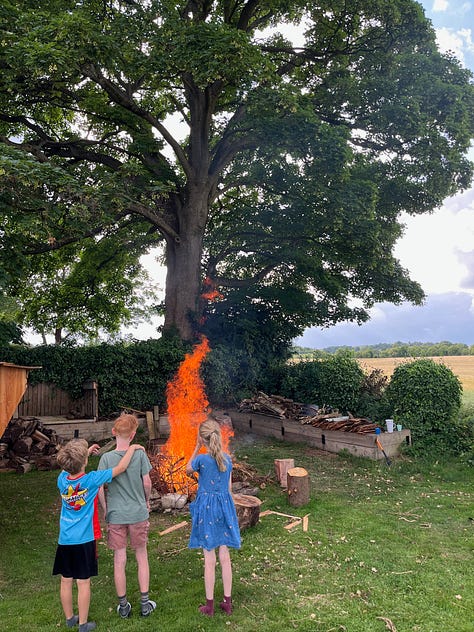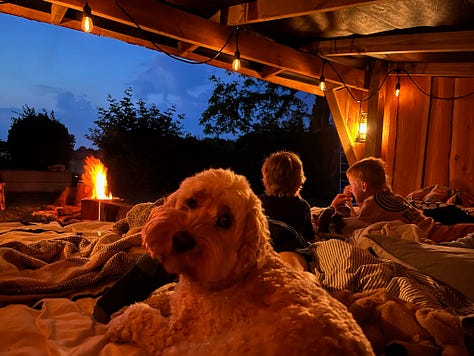How to Hold the Sun: A Danish Midsummer Survival Guide
This week, I had the honour of giving the Sankt Hans bonfire speech for Danes in the UK. In need of a 10 minute caffeinated sunbeam of a pep talk? Here goes...
Explainer: Danes celebrate midsummer on the feast of Sankt Hans on 23rd June with a fire and ‘the bonfire speech’ - usually given by a big shiny person (or, where I lived, someone who looked a lot like the lead singer of Led Zeppelin). So I was chuffed to bits to be asked (and have clearly now entered my Robert Plant era). As requested, sharing my own version of ‘the bonfire speech’ here…
Good evening, Danes, honorary Danes, any casual observers…
If you’re here tonight wondering what on earth is going on - congratulations! You’ve stumbled into Denmark’s biggest emotional release party, complete with singing, fire and folklore
This is Sankthansaften - or Midsummer’s Eve - when Danes, who have a reputation for being rather reserved for much of the year, suddenly start setting things on fire and singing (although the singing part is standard…)
READ: SINGING, ORACY AND FINDING YOUR VOICE IN DENMARK
I always used to say to other internationals: ‘if you want to understand Denmark, don’t come in December. Come in June.
I spent 12 years studying the Danes when I relocated from London to rural Jutland in 2013. I knew nothing. I knew nobody. And nobody knew me. So I started observing and asking questions until I became known as that weird British woman who asks all the questions. A journalist by trade I began to write about my experiences as a Scandinavia correspondent for UK newspapers. And I wrote books about life in the Nordics – The Year of Living Danishly to How to Raise a Viking. Because, spoiler, I also ended up having three children in Denmark and found myself an accidental mother of Vikings in a place where they do childrearing very differently. At least, differently to my own upbringing. I learned about – and learned to love – a very different way of life. And my first ever Sankt Hans was an early introduction to living Danishly.
Because across Denmark tonight, bonfires blaze. On beaches, in parks, by lakes, and on village greens, flames leap into the sky for Sankthans. This tradition goes back centuries, long before Christianity arrived in the North. In the old Nordic pagan customs, fires were believed to chase away evil spirits, to ward off darkness and protect communities for the season ahead.
Midsummer fires were part of ancient fertility rites - symbolising light triumphing over night, heat over cold, life over death. The fire was both a celebration and a safeguard. In the Viking era and beyond, flames on Midsummer night served as a ritual boundary: protecting the world of the living from the shadows creeping in from the other side.
Like a giant seasonal insurance policy.
In more recent centuries, Christian symbolism was overlaid onto these older rites. The holiday was named after Saint John the Baptist - Johannes - hence “Sankt Hans.” But even with the new name, the ancient rituals endured
And so, after ten months of grey skies, days when the sun barely brushes the horizon, now it lingers.
After the cold, dark, rain, sleet, snow, and the general feeling that we might never feel our toes again - June arrives like a caffeinated sunbeam. Suddenly everyone’s outside. Even the introverts. Even that neighbour who hasn’t spoken since November is now outdoors, in shorts, grilling pølser (sausages) like it’s a job
The sun doesn’t set until nearly midnight. The air smells of smoke and hope. And students in little white caps drive around in open trucks looking as though they’re having the time of their lives - which, to be fair, they are. It’s glorious.
READ: DANISH GRADUATION SEASON EXPLAINED (AKA WHY STUDENTS ARE WEARING LITTLE WHITE CAPS EVERYWHERE)
While this is the longest day of the year, it’s also the moment when the days begin to shorten again. Classic Denmark - even the biggest party comes with a quiet existential footnote.
It’s very Danish - to celebrate the height of something - and quietly accept that it’s passing. There’s no “let’s stretch summer out for another eight weeks” energy like we try in the UK, wearing sandals in late September. No: this, now, is the pinnacle of summer. So we should enjoy it.
After today, the days grow shorter. Slowly, imperceptibly at first, but undeniably. It’s a bittersweet joy - this awareness that the light will begin to fade. That summer will not last forever. But rather than resist it, the Danes lean into this transition, honour it - with fire.
Somewhere along the way, Danes decided that this fire should also include a witch – thankfully not tonight but can’t forget what my eyes have seen over 12 summers of living in Jutland.
Yes, in one of the most progressive, gender-equal countries in the world… many still gleefully tossing a lady-shaped straw doll on a fire every June.
This is how it was explained to me when I first arrived in Denmark, by well-meaning friends and neighbours: with a quick history lesson.
The Danish witch-burning tradition dates back to the 16th century, when women were accused, tortured, and executed for crimes as vague as “causing a poor harvest,” “dancing too well,” or, in one infamous case, “peeing on the wrong farm.”
Anne Palles was the last person officially burned as a witch in Denmark in 1693.
But the straw witch tradition emerged in the late 1800s - part cautionary tale, part communal theatre. Legend has it the witch flies off to Bloksbjerg in Germany, where the other witches gather for - I don’t know - cheap lager and bulk buying snacks?
Either way, it’s problematic - that this happens, throughout Denmark, lighting a female effigy on fire, while children scoff flødboller (the Danish equivalent of Tunnocks teacakes) and grownups swig beer and sing songs. In 2025. In one of the most gender-equal countries in the world…
But then Denmark has a complex relationship with its past.
It’s a land of contradictions: progressive yet old-fashioned. Obsessed with both freedom and rules. With Arne Jacoben, Bang and Olafsun and... burning witches on bonfires.
But we don’t have to pretend the past was perfect to celebrate the present. We can acknowledge the dark while still dancing in the light.
And that’s what this night does.
We gather - Danes, internationals, young and old, here - not to erase the past, but to remember it, look forward, and light a fire big enough to hold all of it.
All of us.
The students who made it through the school year. Those far from home, or friends or family. The tired parents, the lonely souls, the outliers, the old timers - all quietly making it work.
Sank Hankts is a time to think back to the person we were last year. The one who didn’t know how things would turn out. The one who was worrying about something. The one who was scared shitless, in my case.



Since my last Sankt Hans I’ve moved countries, moved house, schools, leaving the only home my three children have ever known. Leaving my own home for the past 12 years. Years that have been the formative period of my adult life to date. I’ve had to start over, make new friends, build a new community, understand British bureaucracy after more than a decade of Danish efficiency… It’s a lot. At times, I wasn't sure I’d make it.
READ: The POST I DIDN’T WANT TO WRITE
But here we are. Here we all are. Now. In front of a massive fire. Still standing.
Eventually the sun will go down. And it will rise again tomorrow. The light, the heat will come and go. So will exams, jobs, heartbreak, pandemics, elections. But we’ll gather again. The next year. To celebrate the light.
Tonight, the fire is about togetherness - sharing music, space and time. A communal experience to recharge our batteries for whatever’s ahead. Something I’ve found that Denmark is very good at. Tonight is about samfundssind and singing songs - especially the beloved “Vi elsker vort land” ("We love our land") with the refrain - "but the mother herself is strong and great" - reminding us that Denmark is more than just place. It's tradition. It’s a shared identity kindled again each June.
And while many of us come for the fire, we stay for the feeling - that fleeting, golden moment when time seems to slow. When there is still light at 11pm and you wonder if you even need to sleep.
When worries feel smaller and hopes feel larger.
Danish Midsummer is a reminder of the cyclical nature of things. That endings are also beginnings. That the darkest days have passed, and the brightest days - though brief - are to be savoured.
So tonight, as the fire crackles and conversation, laughter and songs drift across the city, let us carry the light - literal and metaphorical - with us. Let’s remember it.
This moment. A memory of warmth. A flicker of community. The knowledge that, in Denmark or wherever we end up next, we know how to find light, even as darkness returns. Sankt Hans is like a collective reset. An exfoliation: sloughing off what has been and looking forward to what’s to come.
Because that’s the real secret of how Danes survive the dark - they throw a party for the light. And maybe set some stuff on fire…
Until next time, happy Sankthansaften!
Helen






Sounds like a party I should try to make next year. Tak!
Just to complicate things even MORE, the witches seem to do some time travel, as they miraculously gather in Germany on the night of April 30 into 1 May:
https://raredirndl.com/blogs/events/what-is-walpurgisnacht?srsltid=AfmBOorZuyAaUD7XVE2tlExdPedssCSx1CfNaLddPOnXw69luP4hWwuQ
In the alpine regions where I live, they also light fires on the mountains on 23 June to scare off all the evil spirits. It looks AMAZING: (Just install a translate web page extension to get it in English)
https://gipfelfieber.com/sonnwendfeuer-bergfeuer-herz-jesu-feuer-geschichte-termine/